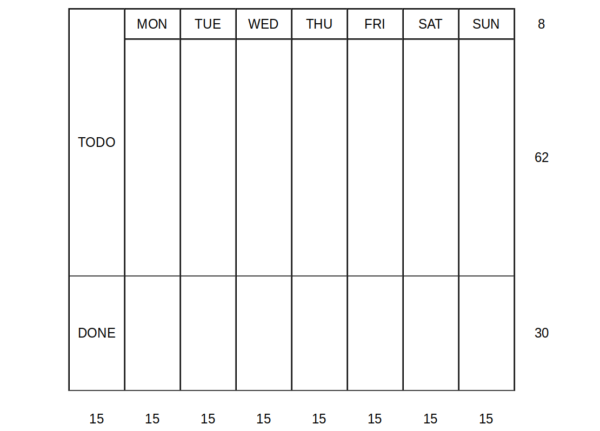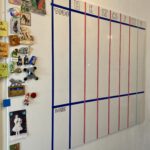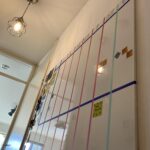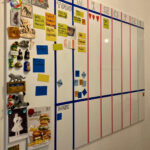To state the obvious (but hey, you gotta start the post somehow), the pandemic upended the lives of a lot of people. As a dad with kids I feel (and I might be wrong) that families with kids were hit worse than average: not only were we locked in, our kids were locked in too.
We’ve been experimenting for a while with various family organisation aids to smoothen our family dynamic but with this latest blow we absolutely needed to clarify how we can operate together as a family.
The parenting context
(This is a section on COVID-19, and on why we needed to define a framework. If you’re only interested in the how and the what, feel free to skip this part.)
We’ve been quite liberal in parenting. We don’t have many hard set rules, we typically ask for chores to be completed instead of commanding, and we are not tyrannical in other areas. We don’t send them to some extracurricular thing every day, we basically have 2 set rules here: they have to learn music (it’s in our family) and they have to do some sports. Apart from this, our kids are pretty free to do as they please — and do as they please they do (as they please.)
However, lately this liberal approach has shown its weaknesses, ever bigger cracks appeared on the surface of our well functioning family. It has a lot to do with the pandemic, I think. Our kids’ schedule got scrambled multiple times: a totally chaotic home schooling period during lockdown #1 in the Netherlands, then, not long after they went back to school and got used to it again, lockdown #2 kicked in disrupting school life just before christmas. And finally, after lockdown #2, they suffered a number of mini-lockdowns: home quarantines due to covid outbreaks in their school units. This kind of uncertainty screws even with a grownup with a job that can be done literally from anywhere. (Hi there.) Add this to the sudden lack of social interactions kids really depend on, and you have two little lost souls trying not to panic over how their happy little life would never go back to how it was.
(Side note: this is not a rant against schools or the school system. I’m absolutely astonished on how they turned the situation around for lockdown #2.)
I don’t want to turn this into a parenting blog, we’re nerds after all, but one area fascinating and terrifying to watch is the kids’ use of computers during this period. We’ve tried limiting computer time since forever, believing that yes, kids need screen time, but no, it can’t go unchecked as there’s a real world out there too. With home schooling this all went to shit of course. Sitting 4-5 hours in front of a laptop for work absolutely rewired their brains, and
they
got
hooked
on the laptop/ipad for their after work hours too. Imagine yourself let’s say sick and bored for a week; when you reach the end of Twitter, 9gag, and the Slashdot comments section. After a while you don’t even go down to the grocery store, let alone do sports. Now you have a generic idea on where their addiction is. After lockdown it took weeks to get back to a somewhat normal screentime schedule, set some screen time rules… just to get hit by lockdown 2 and throw any progress we’d made out the window. This then led to a neglect in all other areas of their lives: an utter disinterest in music lessons, sports, school, and in general, offline life. So not only we had to limit screen time, we have to somehow help them understand what their tasks as family members are (again, to avoid the tyrannical model), to help them what their educational deadlines are, and to make the limits of screen time very clear. We’ve had multiple attempts at this, mostly coming in from the liberal direction: self control on screen time and chores, of course also a result of 2 busy parents, who can’t check dependencies easily before giving permission to “some” gaming… Need I tell you how we failed at these attempts? I need not.
So now we are trying something a bit more radical, a bit more structured.
I will call this Family Agile, or better yet (and spoiler alert):
Family Scrum.
These I know are overused terms, but I can’t find a better one. Custom Tracking Process for Family Chores, Offline Life and Screentime Management is a bit too specific.
Family Scrum principles
So what do we want from our Family Scrum?
- Easy to self manage, easy to understand: half of the team are under 12
- Transparent, easy to control/audit: the other half of the team are busy parents
- Driven by an offline/physical board: after all we want to control screen time not mandate it
- Practical: the offline/physical board has to observe the fact that quarter of the team are under 150 cm (ie. kids’ tasks need to be on the lower half of the board)
- Handle daily (“clean the cat’s litterbox”), weekly (“clean the bathroom”), and ad hoc (“replace the broken protector glass of the iPad”) tasks
- Motivation system to, well, keep us motivated
- Continuous Improvement, change based on consensus (we know we’ll change it, but we don’t do it arbitrarily, we don’t do it mid-week, and we always discuss with the kids before changing)
The framework
For a start, we are going with a Scrum (well, ~Scrum) setup:
- Week long sprints (we call this “a week”)
- Standup every morning (we call this “familymomentje”, but also “breakfast”)
- Planning and retro on Sundays (we call this “sunday lunch”)
- Our backlog is basically all the stuff coming up as todo:
- Daily and weekly recurring tasks can be abstracted as ~devops tasks; maintenance tasks with a fixed assigned bandwidth, but not with a fixed assignee
- Ad hoc tasks we throw in the backlog and prioritise during planning based on our remaining badwidth
- Reward for completing daily batch of tasks is the oh-so-precious screentime for kids (this may or may not be a good idea, but again, I’m not going to turn this into a parenting blog), and less need to constant nagging for parents
Board design
We were (well, I was) contemplating using simple Kanban for this, especially after reading many articles over Agile Family implementations, but I found this to be useless for our purposes: while we do have To Do and Done statuses (To Do for the backlog, Done for the transparency requirement), In Progress adds unnecessary overhead and I can guarantee nobody would it. This status makes sense for bigger tasks, typically multi-day projects with no visible immediate outcome, but for small stuff like the aforementioned cat litterbox activity it really is just unnecessary admin. So ultimately, I ended up with a Scrum Board design like this:

While this is not the best possible way to utilise the space we have (which is around 120×100 cm) and maybe not what a “conventional” scrum board looks like, this horizontal layout enables the shorter members of the team to self manage: pull in tasks if they want to, and set to Done after they are done (which they will absolutely do if they want their screentime.) Additionally, I really wanted to visualise days: in a self organising – self regulating team daily standup and the WiP column is enough to keep this daily discipline, with kids (with our kids at least) the daily breakdown is a musthave.
Board implementation
For the actual board we bought a simple magnetic whiteboard, and I implemented the above design with 3 EUR decor tape I found in Hema:
Actual tasks are color coded: mine is light green, but we also have yellow, dark blue and light blue assigned to family members. Apart from personal colors, we have a couple more, which we have yet to assign somehow in the taxonomy. Right now it seems that orange will be generic housework that someone needs to pick up, with an additional small card of color indicating who has picked it up, and red cards were taken by my younger daughter and cut into little magnetic hearts — perhaps the start of a badge system?…
In any case, let the experiment begin.
At the time of publishing this post, we are 3 days in, and starting to see improvement, although it’s early of course.
So far cards are being moved, activities completed. I do have to call attention to the board, but this to me is a huge improvement over pointing out specific tasks in the house that need to be done. Plus, the junior contingent in our team (we call them “the kids”) already improved the process and proactively started planning their screen time slots to particular weekdays, prioritising it amongst other activities, like playdates or personal projects.
I also have to say, hand on heart, that I fully expect our board to help me in better planning and remembering what home improvement projects I have going on and regain focus on some of them.
And as for the framework itself, I’ll keep blogging away on how this goes, our CI, and the uptake, in the hope of course that this will prove a useful imrovement to family life for the coming what, 8-10 years.
Godspeed!
The yin-yang-ey header image is my own, taken near Den Helder.




2 thoughts on “We are starting on a Family Scrum journey.”